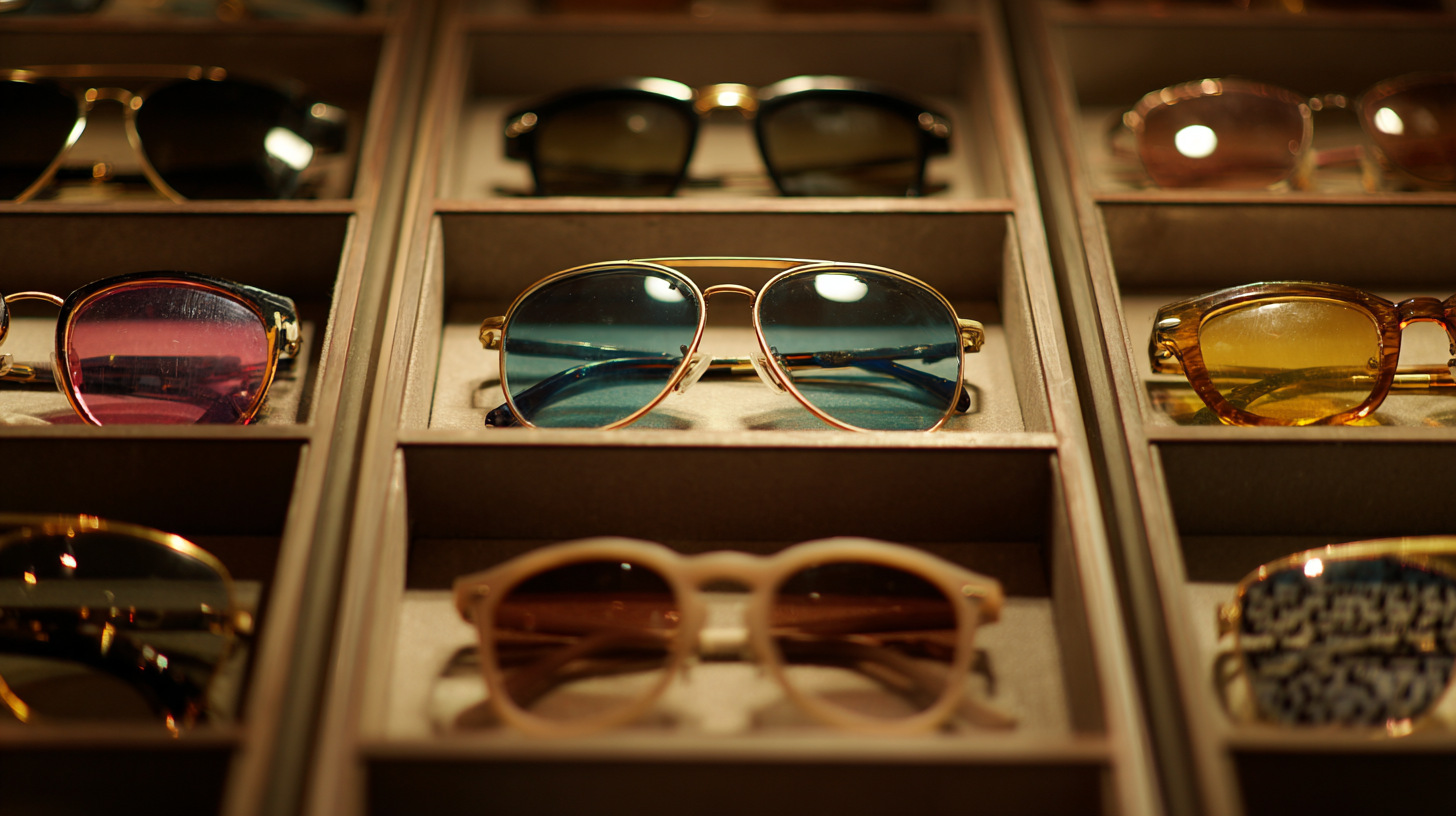Challenges in Sourcing Original Design Spectacles: Navigating Supply Chain Disruptions and Quality Control Issues
Table of Contents
- Understanding Supply Chain Disruptions in Spectacle Sourcing
- The Impact of Global Events on Original Design Eyewear Production
- Quality Control Challenges in Developing Unique Spectacles
- Strategies for Mitigating Risks in Eyewear Supply Chains
- The Role of Technology in Enhancing Sourcing Efficiency for Spectacles
- FAQS
- Conclusion
- Related Posts
You know, in the eyewear world, it’s pretty clear that people are really into Original Design Spectacles these days. Looks like everyone’s craving something that’s both unique and personalized—it's almost like a mini statement for your face. I've read that by 2025, the global eyewear market could hit around $178 billion. A big chunk of that growth? Thanks to cool, innovative designs and craftsmanship that really stand out. Companies like Fansu Eyewear Co., Ltd. are doing their thing with this philosophy of “bright as arrows, soft as feathers”—which explains how each piece is carefully handcrafted, mixing simple vibes with tiny, intricate details.

But it’s not all smooth sailing; sourcing these fancy original designs can be tricky. Supply chain hiccups and quality control issues tend to throw a wrench in the works, impacting the entire industry. Still, as brands aim to deliver top-notch products, understanding these challenges is super important if they want to keep growing and keep customers happy in such a competitive scene.
Understanding Supply Chain Disruptions in Spectacle Sourcing
Finding original designs for spectacles has become pretty tricky nowadays, especially with supply chain issues popping up more often than not. As some recent reports have pointed out, global procurement managers are now more stressed than ever about rising costs and manufacturing hiccups. Things like port strikes and tariffs just add more layers of complication, making companies rethink how they handle logistics and build relationships with their suppliers. For a brand like Fansu Eyewear, which takes pride in detailed craftsmanship and unique designs, these kinds of disruptions can put the quality and timeliness of getting products out the door at risk.
Plus, with the global trade landscape constantly evolving and geopolitical risks on the rise, brands need smarter, more flexible sourcing strategies. Using data and analytics to predict demand and spot potential issues early on has become essential. For Fansu Eyewear, staying resilient against these bumps in the road is key to keeping up their promise of handcrafted, high-quality frames that stand out because of their thoughtful design. Overall, manufacturers who can adapt and think creatively during these challenging times are the ones who’ll come out on top in the marketplace.
The Impact of Global Events on Original Design Eyewear Production
You know, when big global events happen, they really shake up how we produce original design eyewear. Supply chain hiccups seem to be popping up left and right lately. Things like natural disasters, political tensions, or even pandemics can throw a wrench in manufacturing and cause delays in getting products out the door. It’s not just about missing a deadline — it also makes everyone worry about keeping up the quality standards we all care about. Brands want to offer eye-catching, high-quality glasses, but they’re caught in this tough spot: managing these unpredictable disruptions while still meeting what customers expect.
To deal with all this, brands might want to think about spreading out their supply sources. Basically, sourcing materials and parts from a bunch of different suppliers across various regions can really lessen the risk of relying on just one. Plus, putting some focus on technology can help keep communication smooth and make tracking inventory or forecasting much easier.
And of course, quality control is more important than ever. Regularly checking in on suppliers and sticking to strict quality checks can help make sure products stay at the standards fans expect. Building good relationships with suppliers and having backup plans ready goes a long way, too — it helps tackle problems quickly and keeps everything running more smoothly, which means happier customers all around.
Challenges in Original Design Spectacles Production
Quality Control Challenges in Developing Unique Spectacles
Quality control can be quite a challenge when you're creating one-of-a-kind glasses. In today’s super competitive market, brands aren’t just about making things that look good—they also have to make sure every piece hits certain quality standards. Take companies like Fansu Eyewear Co., Ltd., for example; they really stress how important it is to pay close attention to every detail, from the initial design all the way through to the final product. Maintaining consistency isn’t just a bonus; it's a must. Handcrafted frames with smooth, refined edges really drive home the need for meticulous quality checks—these help catch any flaws early on and keep the integrity of the design intact throughout the whole manufacturing process.
And with all the recent buzz around AI tech, things are getting even more complicated. Now that smart AI glasses are hitting the market, brands are scrambling to keep up with demand, all while trying to avoid quality slips that could happen along the way. New tech often shakes up traditional manufacturing, which means brands really have to find that sweet spot between pushing innovation and making sure everything meets high standards. They need to tweak their quality control systems to handle these changes—whether it’s a classic style or the latest tech marvel—so that every product still lives up to customer expectations. Basically, mixing creativity with advanced technology in eyewear means staying constantly vigilant if you want to keep up with excellence and satisfy your customers.
Challenges in Sourcing Original Design Spectacles: Navigating Supply Chain Disruptions and Quality Control Issues
| Challenges | Description | Impact Level | Mitigation Strategies |
|---|---|---|---|
| Supply Chain Disruptions | Delays in sourcing materials due to geopolitical tensions | High | Diversifying suppliers and increasing inventory |
| Quality Control Issues | Inconsistent product quality from different manufacturers | Medium | Implementing strict quality audits and standards |
| Market Demand Fluctuations | Variability in consumer preferences affecting sales | Medium | Conducting regular market research and trend analysis |
| Regulatory Compliance | Adhering to international standards for eyewear | High | Regular audits and working with compliance experts |
| Intellectual Property Issues | Challenges in protecting unique designs from counterfeiting | Medium | Establishing strong IP protections and legal partnerships |
Strategies for Mitigating Risks in Eyewear Supply Chains
Getting a grip on the supply chains for eyewear these days? Honestly, it’s never been trickier, especially since recent global hiccups threw a wrench in the works. I came across this report called Eyewear Industry Trends 2023, and it said that nearly 78% of eyewear makers have been hit hard with supply chain troubles over the past year. No surprise there—it’s made it pretty clear that businesses need to come up with solid plans to handle the risks of sourcing those really cool original design specs.
One good move? Spreading out your suppliers rather than relying on just one or two. According to the International Optical Association, brands that have a bunch of different suppliers tend to face about 25% fewer delays in getting their products out. Also, investing in smarter quality controls—like real-time monitoring tech—can really make a difference. It helps catch problems early and actually reduces the number of returns due to defects, which, by the way, was a headache for about 30% of eyewear companies, based on that same report.
If companies focus on these strategies—diversifying suppliers and upgrading quality checks—they’re much better positioned to handle today's sourcing challenges and still deliver those high-quality, original frame designs that customers love, even with all the chaos going on.

The Role of Technology in Enhancing Sourcing Efficiency for Spectacles
In the constantly changing world of eyewear, technology really plays a big part in making the whole process of sourcing original design specs way more efficient. By tapping into advanced tools like AI and data analytics, brands can smooth out their supply chains, which not only helps keep quality high but also cuts down on unexpected hiccups. These tech solutions let you keep an eye on inventory, track how suppliers are doing, and monitor shipping timelines in real time—making it easier for businesses to stay flexible and respond quickly to what the market wants.
Here's a tip: consider using AI-driven platforms that analyze consumer behavior to spot upcoming trends. This kind of insight can really give you an edge in your design and sourcing decisions, helping you stay ahead of the game and better meet what your customers are looking for.
Plus, digital tools for collaboration make it super easy to communicate smoothly with everyone involved in the supply chain. Building strong relationships with suppliers, manufacturers, and logistics guys means you can spot potential problems early on and fix them before they turn into big issues. Taking this proactive stance not only boosts efficiency but also keeps quality tight throughout the sourcing process.
Another tip: setting up cloud-based project management systems can really improve visibility and teamwork across your whole crew. When everyone’s on the same page, it’s a lot simpler to spot challenges and work together to find solutions.

FAQS
: The main challenges include rising costs, manufacturing disruptions due to global events like strikes, and changes in tariffs which force companies to rethink logistics and supplier relationships.
Supply chain disruptions can jeopardize the quality and timeliness of product delivery, impacting the brand's commitment to high-quality craftsmanship.
Adaptive sourcing strategies are necessary due to the shifting landscape of global trade and increasing geopolitical risks, which can threaten supply chains.
Companies can mitigate potential threats by employing data-driven procurement approaches and utilizing advanced analytics to forecast demand.
A significant challenge is ensuring that each piece meets specific quality standards while maintaining consistency in quality throughout the manufacturing process.
The surge in AI technology has created a race to respond to market demands quickly, complicating quality control as brands must adapt their mechanisms to ensure high standards amid new technology.
Companies must balance innovation with quality assurance to prevent quality control pitfalls while introducing new designs.
Precise quality control is essential for handcrafted frames to identify defects and uphold the integrity of the design throughout the manufacturing process.
Brands must deliver visually appealing designs that also meet high-quality standards while being vigilant about the intersection of creativity and technology.
Market demand can disrupt traditional manufacturing practices, necessitating adaptations in quality control mechanisms to ensure products meet consumer expectations.
Conclusion
When it comes to eyewear, sourcing original design spectacles isn't always a smooth ride. With all the stuff happening globally—like supply chain hiccups—things can get pretty tricky. Production of these stylish frames sometimes gets delayed, and you might notice slight inconsistencies in quality. At Fansu Eyewear Co., Ltd., we totally get how challenging this can be. Every handmade frame we craft is a labor of love, with attention to every tiny detail—making sure the edges are sharp and the finish is just right—despite all the outside pressures.
Related Posts
-

Exploring How the Best Original Design Eyeglasses Will Evolve with Technology Trends in 2025
-

Solutions for Choosing the Best Original Design Eyeglasses for Your Unique Style
-

How to Choose the Best Eyewear Acetate for Your Brand Needs
-

7 Unmatched Advantages of Pure Titanium Optical Products You Didn't Know About
-

Innovative Solutions for Enhancing Your Look with Transparent Eyeglasses
-

How to Choose the Perfect Women Eyeglasses for Your Face Shape and Style
Blog Tags:

